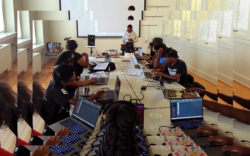Hi! I’m Drea, and I work at Splice—but before that, I was a kid writing songs in my bedroom, a student at NYU, and a young artist learning the ropes of an industry I didn’t quite understand.
Today, I want to share a bit about my journey, how Splice helped me take control of my music, and how we’re working to make music creation more accessible to everyone—especially students and emerging artists.
The start of my journey
My music journey started early. I had my first piano lesson at four, started singing soon after, and by age ten, I was writing songs on guitar. By fourteen, I had signed my first record deal—a surreal experience that, while exciting, often left me feeling isolated. As a young artist, especially one without industry mentors, I didn’t understand how the business worked. I was in the vocal booth, but never behind the screen, and production felt like a secret club I wasn’t invited into.
After a tough experience during my gap year—when two albums of mine were taken from me, likely sold off as demos—I made a decision: I needed to learn how to produce my own music. But, the learning curve was steep. I couldn’t afford a studio or musicians, and I was constantly frustrated by the tech.
Then, one day, in a music business class at NYU, a guest speaker named Jonathan Lee changed everything. He introduced us to Splice—an affordable, accessible platform with a huge library of royalty-free samples. That $7/month subscription gave me creative control for the first time in my life.
Empowered by Splice
With Splice, I could produce from my dorm bed. I started toplining over loops and experimenting with beats. I no longer had to depend on anyone else to bring my songs to life. It was freeing, and it helped me discover a whole new side of my artistry.
Fast forward a few years—after internships at places like The Davis Firm and The Orchard (Sony), I found myself applying for a role at Splice. I started in Business Affairs—helping creators understand their contracts—and eventually found my way to the Content team, where I now run a sample label called Sunday Supply. It’s the home for chillout vibes on Splice, and I’m super proud of it.
The power of sampling
Let’s talk about sampling for a second. If you’re unfamiliar, sampling is the reuse of a portion of a sound recording in a new track. It dates back to the Mellotron in the 1960s and was revolutionized at block parties in the Bronx, where hip hop was born.
Today, sampling is a cornerstone of music production. Splice makes it easier than ever to sample legally, ethically, and creatively—with over three million sounds across 130+ genres ready to drop right into your DAW.
Solving the two biggest barriers to music production
When I think about what Splice solves, I always come back to two problems I experienced as a young creator:
1. Tech overwhelm
The time between that spark of inspiration and actually finishing a song can be full of technical headaches—DAW issues, plugin confusion, crashes. Splice helps eliminate those roadblocks with tools like:
- The Splice desktop app: Syncs sounds directly into your session.
- Create mode: Lets you quickly build ideas using loops, right from the app.
2. Cost barriers
Let’s face it: Music production can get expensive. Studios, gear, plugins… it adds up fast. Splice helps level the playing field with:
- Sound library access: ~$13/month gets you a universe of royalty-free samples.
- Rent-to-own plugins: Like Serum, which I personally used for just $10/month.
Behind the scenes at Splice: How we make sample packs
I’m part of the Content team at Splice—the crew that curates, creates, and releases the sounds you use.
Here’s what goes into making a sample pack:
- Trend-spotting: We stay tapped into what’s next using instinct and data.
- Curation: We find the right artists, build references, and shape the vision.
- Production: We record, edit, and run a rigorous quality control process.
- Release: Once it’s ready, it’s uploaded to Splice for the world to use.
Our packs have been downloaded millions of times—and you might recognize them in songs by artists like Sabrina Carpenter, who used a Splice sample in “Espresso.”
Your turn: Start creating
We believe music creation should be accessible to everyone—whether you’re in a studio, a classroom, or your bedroom.
If you’re a student who’s curious about Splice, you can get started with a discounted Splice for Students subscription today or talk to your teacher about getting set up with a free classroom trial. Download the app, explore the sounds, try Create mode, and see how Splice fits into your creative workflow. Maybe you’ll even start your own label—just like I did.
Music production doesn’t have to be intimidating or expensive. With Splice, you have the power to take control of your sound, your ideas, and your creative future.
Are you a student and ready to try Splice for yourself? Start here.
Are you an educator who’s interested in getting your students started in the classroom? Start here.
Otherwise, you can stream my album here and stay in touch via Instagram or TikTok!
May 21, 2025

.svg)
.svg)




